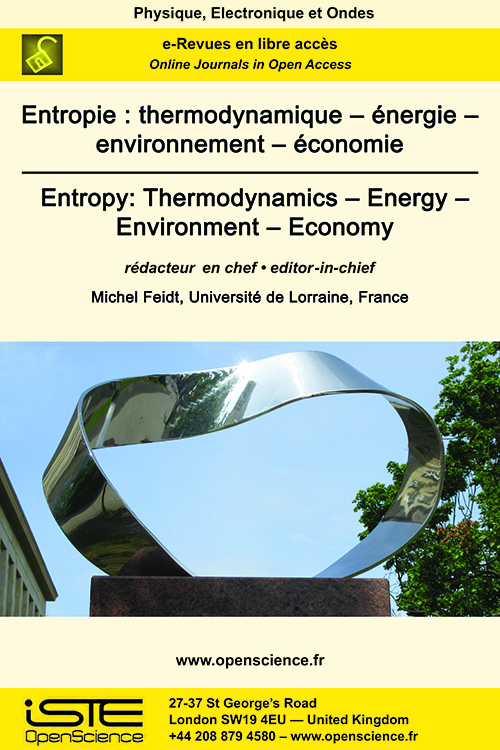

Physics > Home > Entropy: Thermodynamics – Energy – Environment – Economy > Issue
La revue Entropie offre un forum pour la publication de contributions originales et d’articles techniques complets de recherche interdisciplinaire et originale sur tous les thèmes autour de l’énergie, de son utilisation, et des processus de conversion, de thermodynamique physique, technique ou de thermo-économie, d’entropie sous ses diverses présentations, et bien d’autres sujets comme les propriétés des matériaux et des fluides….
In this paper, we present a planar thermoelectric microgenerator (μTEG) based on CMOS-compatible silicon technology to harvest all forms of thermal energy. These have made by using low cost, abundant and eco-friendly materials. The heat harvesting has performed with a silicon concentrator. The developed semi-3D configuration needs safety support called ‘boss’ to avoid the breaking up of the membranes. The objective of this work is to evaluate the improvement of these μTEGs performance resulting from the reduction of lateral heat losses by using selective anodizing of these bosses. The thermal modeling of μTEGs embedding porous silicon bosses shows an increase in output power up to 65%.
A few authors have determined exergy behavior of human body under standard conditions. Some of these studies include estimate of life expectancy based on the association of entropy creation / exergy destruction and rate of living theory. Metabolism is known as the major source of irreversibility in human body. Thus, metabolic alterations are expected to affect its exergy behavior and, according to rate of living theory, life expectancy. Some authors discovered that even smokers without smoking-related diseases present metabolism higher than non-smokers, which contributes to weight gain after smoking cessation. According to medical literature, metabolism of smokers is 20% greater than non-smokers, in addition to the known thermogenic effect after cigarette smoking. In the present work, exergy analysis is applied to human body in order to evaluate the effect of metabolic increase in smokers on exergy behavior and life expectancy. The analysis takes into account exergy rates and flow rates due to convection, radiation, respiration, evaporation and exergy metabolism. A multi-segment thermal model of human body available in literature is utilized to perform First Law analysis. Results of destroyed exergy integrated over life span indicate that a smoker destroys around 730 MJ/kg more exergy than a non-smoker until the age of 73.5, which would represent a decrease of 15 years in life expectancy for this group.
This work presents a first optimisation approach based on Finite physical Dimensions Optimal thermodynamics - FDOT-. The optimisation approach is applied for an organic Rankine cycle activated by a solar loop. Consequently, the heat received by the solar collectors is transmitted to the thermodynamic cycle in order to produce useful work during the expansion step of the working fluid. Therefore, a detailed analytical development of the optimisation method carried out for the energy system aiming to maximise the output mechanical power. This approach mainly target the optimisation in terms of temperature, heat exchanger efficiencies and heat flow rates.
Invented in 1984 in a few days, the concept of additive manufacturing has been developed quickly enough to reach a global market of around 40 billion €/year with a 20% annual growth rate. Although the first technology was the space resolved polymerization of resins induced by light, other manufacturing methods have emerged since this founding date allowing the realization of objects in multiple materials. From the first proofs of concept, incremental mono-disciplinary improvements have been made leading to the current success. Today, other application spaces are emerging by exploiting the ability of certain materials to change their shape (and functionality) in the presence of a stimulation. This is how two sister technologies, 4D printing and bio-printing, were born with potential markets of several trillion €/year. But, for these transitions to be as successful as expected, we must accept to explore complication (4D) and complexity (Bio-printing). This observation therefore imposes an epistemological reflection into which scientists should deeply involve, in order to find ways of progress that avoid confining ourselves to an “autistic conduct” with an accumulation of proof of concepts. This article provides reminders on the theme of additive manufacturing, but above all it attempts to show how complexity has silently entered the dynamics of research on the theme, itself limited by the small number of researchers and by the classical difficulty of treating inverse problems and teleological approaches in research.
The common formulations of the second law of thermodynamics link entropy and time in an almost exclusive way: "the entropy of an isolated system increases with time". This applies to both historical (Carnot, Clausius) and statistical (Boltzmann, Gibbs) formulations. This presentation does not facilitate an intuitive understanding of the entropy. Moreover, it does not allow us to see the conceptual unity behind two very different contents, one dealing with quantities of heat divided by temperatures, the other with a number of microscopic states ensuring the same macroscopic state. These difficulties are alleviated if we insist on the role of the spatial variable and its gradients. Thus the two usual formulations can be repeated in this sense, the first by saying that "heat naturally goes from hot to cold", and the second by saying that "an isolated heterogeneous system evolves in a more probable way towards homogeneity". This shows the conceptual unity of the second law: it expresses that, in an isolated system, heterogeneities, whether of temperature or other parameters, tend to decrease. Various topics are examined in the same frame: the notion of equilibrium, the question of time and space scales, the distinction between work and heat, the time problem etc.

2025
Volume 25- 6
Issue 12024
Volume 24- 5
Special issue LILA 22023
Volume 23- 4
Issue 12022
Volume 22- 3
Issue 12021
Volume 21- 2
Special issue2020
Volume 20- 1
Issue 1